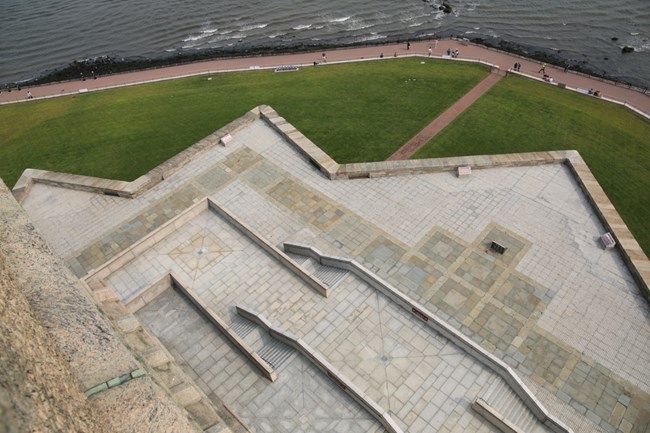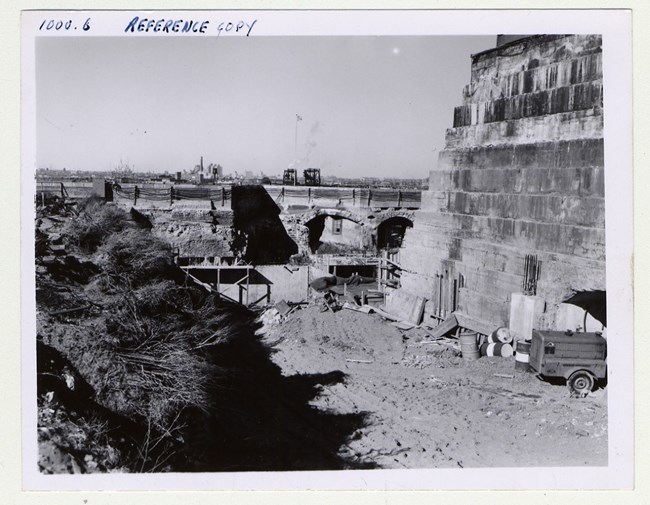
NPS Photo 2024 Project UpdatesNovember 2025 - The Terreplein project is completed. 
NPS Photo 2020 What’s happening?The National Park Service has begun construction on a $27.5 million project to make repairs to the historic fort that serves as the foundation for the Statue of Liberty and its pedestal. Funded by the Great American Outdoors Act (GAOA), the project will make drainage and safety improvements that will help preserve the structure and enhance accessibility for visitors. 
Photo: STLI 24337 National Park Service (Statue of Liberty National Monument) May 6, 1934 Why are we doing this project?Fort Wood is an eleven-pointed, star-shaped fort built between 1808 and 1811 as part of New York’s harbor defense system. The terreplein is an element of fort architecture from this time period where guns and cannons were mounted on an elevated flat surface behind the parapet wall of the fort. In the early 1880s, in preparation for construction of the Statue of Liberty, the structures inside the fort were knocked down and the statue’s pedestal was built inside the stone walls. After the Statue of Liberty was constructed on its pedestal in the middle of Fort Wood in 1886, there were many ideas for what to do with the area between the interior of Fort Wood’s walls and the pedestal. Ultimately in 1907, this space was filled with earth creating the walking plaza at approximately the two-story height you see today that overlooks New York Harbor. This fill was temporarily excavated in the 1960s to construct the American Museum of Immigration, which surrounded the pedestal. The last major rehabilitation of the terreplein surface occurred during the 1980s restoration of the Statue of Liberty. In the ensuing 40 years, the paving has deteriorated and freeze-thaw cycles in the earth underneath has led to heaving and displacement of the pavers. 
Photo: STLI 44203 National Park Service (Statue of Liberty National Monument) February 16, 1963 Crumbling and displaced granite and bluestone pavers throughout the terreplein is the most concerning issue in need of treatment today. These poor conditions pose tripping hazards and severely limit accessibility for visitors. Additionally, the deteriorated surface allows rainwater to pool and leak inside and underneath the walking plaza causing myriad issues to the interior spaces below, some of which house the Statue’s electrical and mechanical infrastructure. This project will also add a waterproof barrier to areas of the terreplein that cross over these spaces. Repairs will be made to the exterior staircases at the base of the pedestal, specifically to ensure the granite cladding is anchored well into the substructure. Structural work will also be completed to the slab that supports the terreplein where it crosses over open spaces in the lobby and utility rooms inside the fort. The park’s historical resource specialists are working closely with architects, engineers, and masonry experts to make sure these repairs are in keeping with the character and appearance of the fort and pedestal. While these structures are overall in good condition, this project will ensure that visitors can enjoy their time on the terreplein for many years to come. 
NPS photo What to expect during your visit?Liberty Island will remain open during the rehabilitation effort, but because the project takes place at the base of the Statue of Liberty’s pedestal, there will likely be noise, dust, and the visual intrusion of construction activity during your visit. You will see large equipment around Fort Wood and you may hear saws and other equipment operating. As work progresses, temporary closures of walkways and gathering areas will be put in place to ensure everyone’s safety. We understand that this project may impact your experience at the park. We are tasked with caring for all elements on the island, from the grass to the Statue itself, and carrying out this project is one aspect of that responsibility. Our goal is to preserve Fort Wood and the Statue of Liberty the best we can so that future generations may enjoy these impressive and important structures. When will construction be complete?Rehabilitation is underway now and is expected to be complete by late 2025. |
Last updated: November 21, 2025
